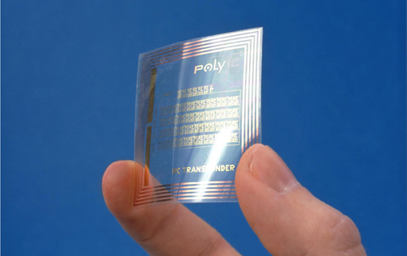polymer electronics
Polymer electronics means as much as plastic electronics. Certain polymers can be doped and, after doping, have the properties of conductors, semiconductors and non-conductors. Polymer electronics is also called organic electronics or by the artificial word polytronics.
Polyacetylene is one such polymer whose conductivity changes by 20 powers of ten between non- conductor, semiconductor and conductor depending on the doping. Polymer electronics uses these processes to manufacture organic semiconductors, such as organic transistors, displays made of Organic Light Emitting Diodes( OLED) or Light Emitting Polymer( LEP).
Electronic components and assemblies in printed polymer electronics
Polymer electronics can be used to manufacture components and circuits with electronic properties from polymer semiconductors. The manufacturing process is much simpler and less costly than that of single- crystal semiconductors because it is done with conventional printing machines, which are used to print electrically conductive plastics onto polyester films or paper webs.
Unlike silicon devices, the production of polymer devices does not require complicated vacuum and high-temperature processes or complex lithography technology. The polymer materials are dissolved in suitable solvents and can then be printed using a printing press or, like conductive ink, can also be created using inkjet printing. In this context, one speaks of printed electronics.
In printing, one layer follows another: Conductors, semiconductors, insulation layers and protective covers. With these printed electronics, transistors, diodes, resistors, capacitors and inductors can be combined to form circuits that are extremely thin, very light and flexible, and can be produced cheaply. Polyester or polyethylene terephthalate( PET) serves as the carrier material.
In this way, not only electronic circuits can be produced, but also batteries and power supplies with organic solar cells, rectifiers and storage capacitors, which obtain their energy from electron-magnetic waves picked up by antennas and oscillating circuits.
Basis and applications of polymer electronics
The basis of polymer electronics is electrically conductive plastics, in which the current flows via the organic chemical molecules of the plastic. Since polymers are non-conductors, charge carriers must be injected so that they conduct electric current. Depending on the doping, this technology includes conductors, semiconductors and non-conductors, which are combined in various structures and thicknesses.
Applications for polymer electronics include flexible RFID tags, roll-up flat panel displays, flat keyboards, organic solar cells, sensors and actuators, printed batteries and accumulators, optical filters, polymer chips, organic field-effect transistors( OFET), OLEDs, and photovoltaic and organic photovoltaic devices and components. The latter, organic photovoltaics, is one of the major technologies of the future.
The Organic Electronics Association( OE-A) is an interest group for polymer electronics and printed electronics.


